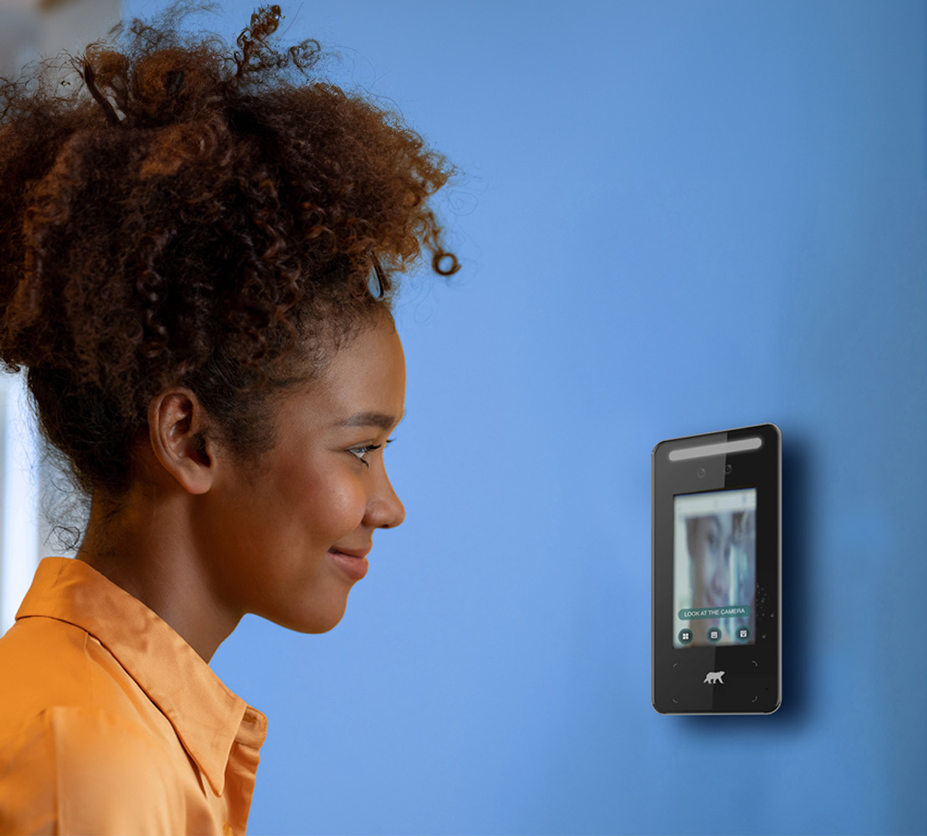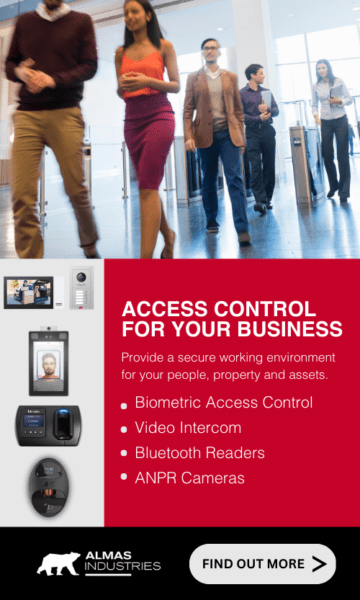
The Pros and Cons of Different Access Control Systems
Every Access Control System has advantages and disadvantages.
The security of buildings and premises is, of course, extremely important, whether they are businesses, homes or government facilities. Over time, increasingly sophisticated methods have been developed to prevent unauthorised access and ensure security. These more modern methods not only delivery better security, but lead to better planning, efficiency and user experience.
In this article, we will take a closer look at a variety of common access control systems: biometrics, RFID (generally fobs or cards), NFC, Bluetooth, QR codes as well as traditional keysWe will go into detail about their different pros and cons and explain to you why they are so effective.
Click on the Access Control systems below to investigate more!
BIOMETRIC ACCESS CONTROL
Security Level: HIGH
STRENGTHS
- Achieve top-tier security with unique physical characteristics like fingerprints or facial features.
- Traditional access methods are vulnerable to borrowing, loss, theft, or forgetfulness.
- Biometric access verifies both ID possession and identity.
- Almas Industries employs a two-stage data capture and alienation process for biometric security.
- Biometric templates are securely stored in software, not as raw fingerprint images.
- Ensure robust security barriers for access to vital business areas.
WEAKNESSES
- Biometric systems, like any technology, may experience technical issues such as false detections or alarms, though rare.
- Thorough implementation and regular maintenance are vital to mitigate potential vulnerabilities and ensure reliable performance.
- Battery backup with a UPS is crucial for biometric access control during power outages, as practiced by Almas Industries.
- Keep fingers clean for optimal performance and be aware that face scanners may require a moment for recognition depending on the model.
CONCLUSION
Biometric access control systems provide robust security by ensuring access data cannot be borrowed, lost, or stolen. Encryption technologies preserve data integrity, making manipulation impossible even in a breach. Secure transmission methods further protect biometric data during transit, fortifying the entire access control system against cyber threats.
BLUETOOTH
Security Level: MEDIUM TO HIGH
STRENGTHS
- Flexible, wireless access control for protected areas
- Enables convenient identification and access for authorised individuals
- Medium to high security with advanced encryption and authentication protocols
- Adjustable wireless range for enhanced flexibility
WEAKNESSES
- Potential weaknesses in Bluetooth access control despite advanced security
- Threat of interference from other Bluetooth devices
- Security vulnerabilities in Bluetooth implementation may lead to unauthorised access
- Importance of keeping Bluetooth systems up to date with latest security standards
CONCLUSION
The future landscape of access control is poised to be shaped by wireless technologies, notably Bluetooth, which offer a blend of convenience and security with enduring potential. The ongoing evolution of Bluetooth, particularly Bluetooth Low Energy (BLE), holds promise for the emergence of more energy-efficient solutions. Already, Bluetooth devices can seamlessly integrate into holistic building management systems, hinting at the expanding role of this technology in shaping the future of access control.
RFID (RADIO FREQUENCY IDENTIFICATION)
Security Level: MEDIUM
STRENGTHS
- RFID access control systems provide robust security in the medium to high range.
- Utilises wireless radio communication for quick and convenient access.
- Transponders or key cards offer long service life and can be blocked if lost or stolen.
- Transponders can be programmed multiple times for additional functions like activating alarm systems.
- RFID enhances work process optimisation with its speed and efficiency.
WEAKNESSES
- Despite RFID's advantages, it poses vulnerabilities like intercepted or jammed wireless communications.
- Implementing encryption technologies is essential to safeguard data integrity against potential breaches.
- Default encryption provides sophisticated protection but requires additional security measures.
- Theft or loss of RFID cards may grant unauthorised access, necessitating strict handling guidelines and rapid response protocols.
CONCLUSION
RFID systems' long-term potential is defined by their adaptability and integration options. Beyond efficient access control, this technology facilitates seamless connections with other corporate systems. The capability to analyse and optimise data establishes a foundation for continuous adaptation to evolving business requirements and ongoing enhancement of security measures.
NFC (NEAR FIELD COMMUNICATION)
Security Level: MEDIUM
STRENGTHS
- NFC access control systems offer convenient and user-friendly access to protected areas.
- Wireless data transmission enables quick identification and access for authorised individuals.
- Provides solid mid-range security with its short range, minimising unauthorised access risks.
- Easy handling and integration into mobile devices make NFC an efficient solution for companies.
WEAKNESSES
- NFC's limited range, while advantageous, poses potential weaknesses as close proximity could allow unintended access.
- Risks include data manipulation or interception during wireless transmission.
- Implementing security protocols is crucial to safeguard data integrity and prevent unauthorised access.
CONCLUSION
NFC propels access control into the realm of physical digitalisation, offering swift, contactless authentication and seamless integration with mobile devices, defining its enduring potential. Anticipated advancements may broaden its scope, introducing innovations like mobile keys or location-based access authorisations, thereby bolstering efficiency and user-friendliness across diverse applications.
QR CODE
Security Level: LOW TO MEDIUM
STRENGTHS
- QR code access control systems offer a simple and cost-effective way to access restricted areas.
- Quick identification is enabled by scanning a code with a suitable device.
- No need for producing, issuing, or sending access media; Users always have their code on their mobile phone.
- QR codes provide low to medium security due to their limited complexity, making them susceptible to counterfeiting.
- Efficient for applications with low security requirements.
WEAKNESSES
- QR code access control systems have limited security due to the ease of replicating QR codes.
- Unauthorised individuals may attempt to make copies to gain access to restricted areas.
- QR codes can be easily shared and duplicated through photography or screen recordings.
- Businesses should remain vigilant of the potential for unauthorised access and take necessary precautions to mitigate risks.
CONCLUSION
QR codes provide a cost-effective and highly scalable access control solution, prized for their simplicity in both implementation and use. Their inherent appeal lies in the straightforwardness of their application. Looking ahead, advancements may introduce enhanced security features to bolster protection against unauthorised access, without sacrificing user-friendliness.
TRADITIONAL KEYS
Security Level: LOW
STRENGTHS
- Traditional keys are a simple and cost-effective means of accessing protected areas.
- Their physical nature makes them intuitive and easy to understand.
- Ideal for environments with low security requirements, providing a straightforward solution.
WEAKNESSES
- Traditional keys have low security as they are vulnerable to loss, theft, and unauthorised duplication.
- Losing a key poses a risk of unauthorised access.
- Copying keys is easy and only requires physical access to the original, compromising security.
- Less suitable for mission-critical areas with higher security requirements due to these vulnerabilities.
CONCLUSION
While traditional keys may not allow for technological advancements, companies can explore modern locking systems based on electronic technologies. Electronic door locks featuring advanced authentication methods offer heightened security compared to traditional keys. While traditional keys remain practical in less security-sensitive environments, transitioning to modern and secure access control systems is advisable for business-critical areas.
Don’t Wait Until It’s Too Late: Secure Your Business’ Future Today with Almas Industries
The commercial landscape is in a state of constant flux, and so are the security challenges that come with it. There’s no time like the present to reassess and fortify your access control system.
Here are three reasons why you should reach out to us now.
1. Stay Ahead with Innovative Solutions: In a world where threats are becoming increasingly sophisticated, settling for outdated security systems is not an option. Our cutting-edge biometric and CCTV solutions ensure that you’re not just keeping up but staying ahead.
2. Tailored for You: Generic solutions often lead to vulnerabilities. We offer a bespoke approach to security, designed to meet the unique needs and challenges of your commercial business.
3. 24/7 Exceptional Customer Service: Security is a round-the-clock concern, and so is our customer service. From installation to regular maintenance checks, our support teams are always at your disposal to ensure seamless operation. Our installation and feedback scores from our customers in the last year consistently score over 4.5 out of 5.
Call us today on 0333 567 6677 (UK) or 01 68 333 68 (IRE) to book a free site visit with one of our friendly security consultants and start future proofing your access control, today.




